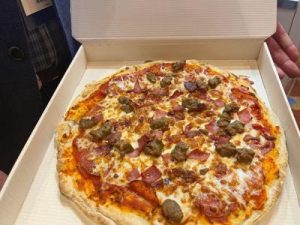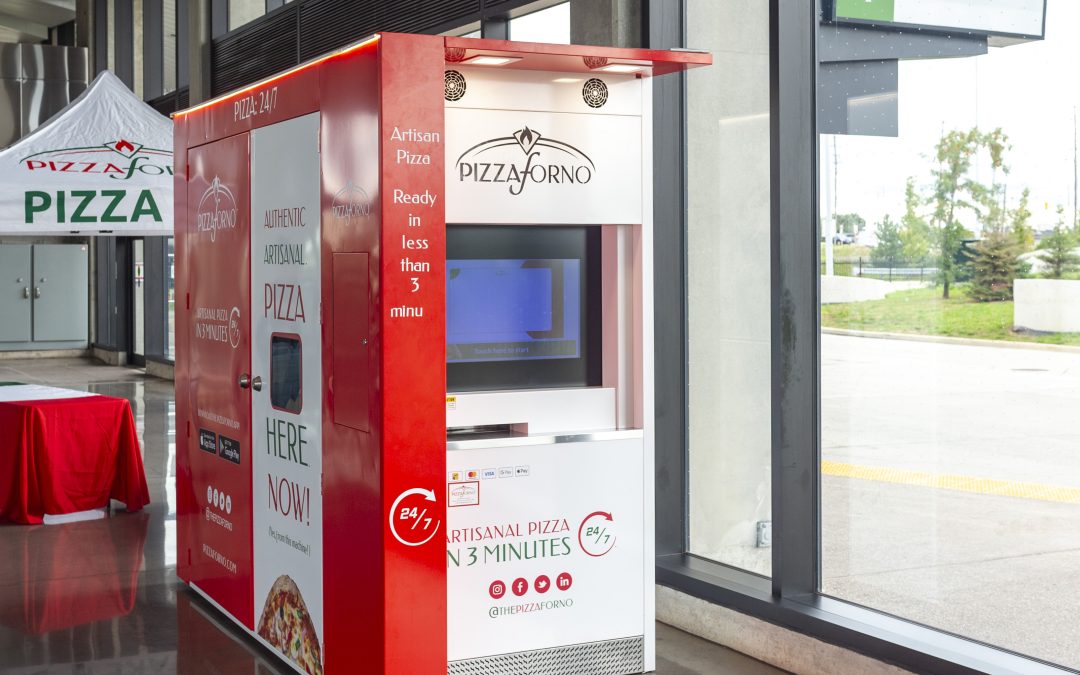The dream of every college student is now a reality: a pizza vending machine, open 24/7. Now if something can be done about 8 a.m. classes.
Toronto-based PizzaForno has rolled out this gooey fantasy in its first California location in Rancho Cordova. The vending machine contains six pizza choices: cheese, pepperoni, meat-lovers, breakfast, vegetarian, and barbecue chicken. Once ordered, robotic arms lift the frozen pizza out of the box to send through the machine’s conduction oven. Once done, the arms place the pizza back in its box to prepare for vending. The whole thing takes about three minutes. A machine can store and make up to 70 pizzas at a time and a 12-inch pizza costs from $10 to $13.
The company has been turning heads with its technology since it unveiled it in 2022 at the Restaurant Finance and Development Conference. The company now has 64 machines in 12 states in the U.S., along with machines in Canada, where it started, and Mexico, where it debuted in June of this year.

Les Tomlin, CEO of PizzaForno
“We have more than 100 on order for the next 12 months between Canada, the U.S., and Mexico,” said CEO Les Tomlin in an interview.
Pizza is a $50 billion a year industry and to get any fraction of that pie could be lucrative. Tomlin is betting big on his technology.
But are vending machines really where growth is? Do consumers really want to take the emotional risk that the pizza won’t drop and they’ll have to shake the machine like they do for a dangling Twix bar?
Tomlin thinks they will. He presents a solid business case for prospective franchisees who are willing to sign up for an estimated $145,000 in start-up costs. “Food robotics are the future and the future is here,” he said. “We eliminate obstacles for operators that exist today, like labor costs and square footage.”
The cost of goods sold is favorable with these pizzas compared to that of a pizzeria. If the price of a pizza at a store is $12 and costs $4, the gross profit margin is 66 percent. After accounting for expenses, such as staff, rent, and utilities, the net margin is 10 percent to 15 percent. PizzaForno, with its reduced overhead, comes in around 30 percent.
 How many pizzas does a machine need to eject to be profitable?
How many pizzas does a machine need to eject to be profitable?
“Our benchmark is 25 pizzas a day,” said Tomlin. “if you do 25 you have a viable business. If you do 35 you have a very viable business. More than that you’re a rock star.”
And here’s the wild part. If a machine isn’t successful for a franchisee in a location, PizzaForno can just move it.
“With us you’re not investing $600,000 in a bricks-and-mortar buildout,” Tomlin said. “You can put a PizzaForno machine on the back of a flatbed tow truck and relocate it and have it operating in the same day.”
The machines do well in hospitals, gas stations, and, you guessed it, on college campuses, where sales rise between 11 p.m. and 3 a.m. Ah, college.
PizzaForno’s best-selling location is in the Gulf of Mexico in a place called Crystal Beach on the Boulevard Peninsula. It does 100 pizzas a day. It’s a resort town that has part-time residents with vacation homes and college students coming in on the weekend for the beach. There aren’t any other hot-food options for 10 miles. It’s the ultimate sweet spot for the company. “The owner restocks the machine more than once a day,” said Tomlin.
Vending machines have been around for a while
That’s not to say PizzaForno got there first. Pizzas in vending machines have been around a long time. Just not in the U.S.
In Europe they’ve been available for nearly 20 years. Tomlin used a machine in France in 2017 and was amazed that the machines hadn’t made it to North America.
“My business partner and I were in a beautiful little town two hours north of Paris and saw an 85-year-old woman buy a pizza out of a wall. Light bulbs went on over our heads,” he remembered. They procured North American rights from the French vendor and voila.
He has competitors. Let’s Pizza has machines. So does Smart Pizza. And Resto’Clock. The technology has pretty much gone open source.
PizzaForno’s production is centralized at a facility outside of Chicago, where all proteins are cooked and crusts are baked 90 percent of the way through. The pies are then frozen, wrapped and shipped in bulk to PizzaForno licensees.
With the introduction of a machine in Rancho Cordova, will the rest of California prove to be a fertile market?

Professor Rob Wassmer of Sacramento State University
“It could,” said Rob Wassmer, an economics and urban policy professor at Sacramento State University. “Food costs and labor costs are big issues in California, particularly the $20 minimum wage law. This all fits into what could be the rise of robotic pizza vendors. Restaurants run on tight margins and if someone can put one of these up and not worry about an employee not coming in or treating a customer poorly, that could be appealing. I suppose the important thing is flavor.”
Well, yes. Awesome tech aside, the quality of the food is always going to be the first, second, and third most important variables.
Some consumers have reported that the pizza is just OK. Nothing terribly different than cooking a pie at home, which is also an option with these machines, to take an order home for heating there. But as any college student will tell you, any pizza is good pizza. And as Tomlin will tell you, the proof of concept is in the growth. And his company is growing.
Could vending machines prove a viable competitor to the big chains?
And the food applications of course aren’t limited to pizza. Many restaurant companies in different categories are selling through vending machines, including Wao Bao with its menu of Asian street food and RoboBurger.
In Japan, hot-meal vending machines are popular. “Japan is well known for that. You pull off the road, there are vending machines that provide all kinds of hot meals. I think they provide sushi, noodle dishes, and such,” said Wassmer.
And who knows? If machines continue to receive consumer adoption, Wassmer can see a scenario in which budding operators might ponder that choice over a more expensive investment in a QSR.
“It could be that one day folks wonder, should I buy a Domino’s franchise or a vending machine?” he asked.


